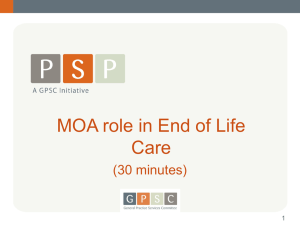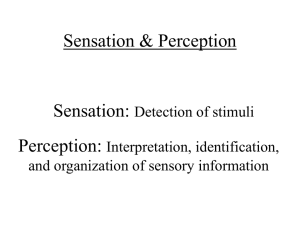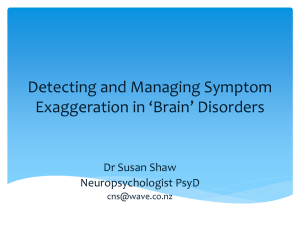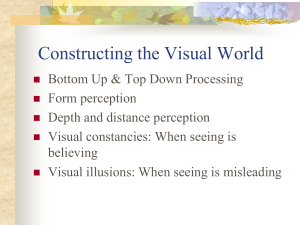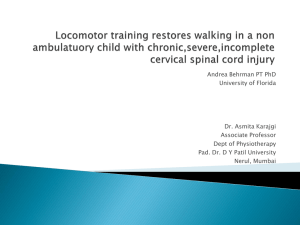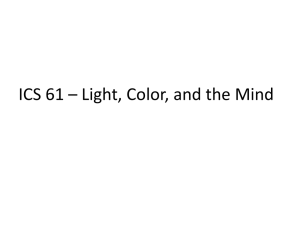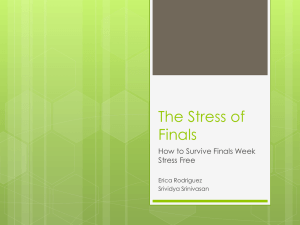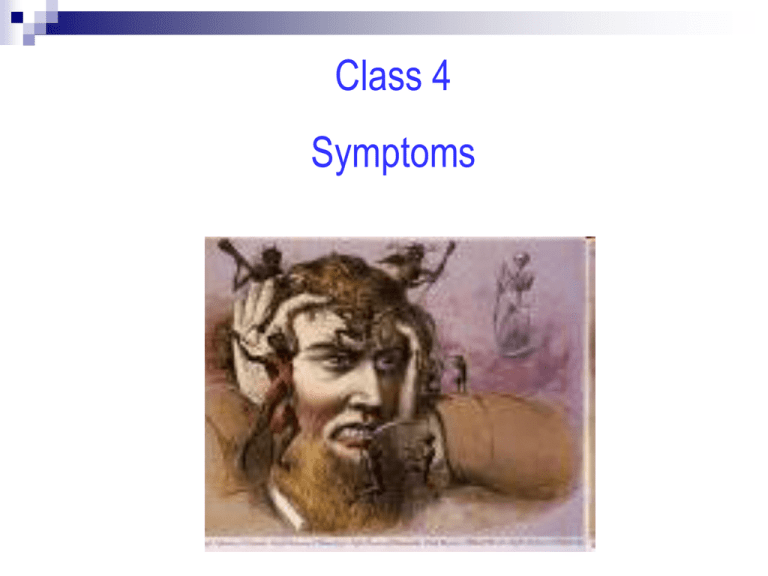
Class 4
Symptoms
Symptom Defined
“A physical symptom or sensation is a
perception, feeling, or even belief about the state
of our body. (It)… is often—but not always—
based on physiological activity. Above all, a
physical symptom or sensation represents
information about internal state.”
Pennebaker, 1983, p.1.
Functions of Symptoms
Why do we have symptoms?
Sign that problem exists
Provide clues to nature of problem
Locate problem
Provide means to inform others of problem
Provide clues how to treat/respond
to problem
The Psychology of Symptoms: Main Questions
1. How do we first notice symptoms? How do we know that a
symptom is “happening”?
2. How do our beliefs about illness and our own bodies affect the
way we interpret symptoms?
3. How well do perceived symptoms match up with actual physical
states?
4. How do people categorize symptoms?
5. How do people differ in the ways that they report on symptoms?
Labeling Symptoms
Shortness of breath means?
____slow/labored
____rapid/shallow
Tense muscles makes you think of? ___Back ___Shoulders ___Chest ____Legs
"Dr., I have shortness of breath and muscle tension" could mean:
Slow, labored breathing
Rapid/shallow breathing
Tense back, chest
Tense shoulders, legs
Slow, labored breathing
Rapid/shallow breathing
Tense shoulders, legs
Tense back, chest
Ways that People Differ in Symptom Reporting
Psychological
Emotionality
Coping style
Demographics
Age
Sex
Marital status
Residential status
Occupational status
SES
Race and culture
Symptom Reporting: Number of, Attention to Symptoms
Rates of symptom
reporting could be due to:
X Numbers of actual symptoms
____
X Differential attention to symptoms
____
X Number & Attention
____
Conditions of Perception
Limited capacity to process information
Info exists inside and outside person.
Perception can be both passive and active
Elements of Perception
1. Orienting:
Does cue (event/sensation) get our attention
Unique? Complex? Mobile?
2. Schemas: Expectations, pre-set ways of understanding events.
3. Inference: Drawing conclusions from available information
Schemas and Symptoms
Schema: Concept or framework that helps interpret or organize information.
House tour as a:
Realtor
Burglar
Recall?
PMS and expectations of PMS symptoms (Ruble, 1972)
Women know about PMS and associated symptoms
Women told period due in 2 days or in 10 days – in fact, all due in 7 days.
All women asked “To what extent are you currently experiencing PMS?”
Result? Women told period starts in 2 days report more current PMS symptoms
Inference and Symptoms:
Combining Orientation and Schemas
Inference: Drawing conclusion from symptoms, as guided by schemas.
Schema?
Orientation?
Inference?
I have a slight headache
=
Orientation
Got new glasses; told might induce headache
=
Schema
I probably have a headache b/c of new glasses
=
Inference
Key terms: Inference, Orientation, Schema
Symptom Reporting and Competition of Cues
Pennebaker
Symptom perception = perception in general. Same processes.
Orienting, Schemas, Inferences
Limited information processing capacity.
Perception is both passive and active.
Info exists inside and outside organism; all info (internal and external)
used to understand events.
Perception is Driven By:
Cue Salience
(A. Triesman)
Person's Plans,
Expectations
Person's
Physical State
(D. Simons)
(D. Proffitt)
http://www.youtube.com/wat
ch?v=vJG698U2Mvo
Pennebaker Symptom and Exercise Studies
How does attending to internal cues or external cues
affect feelings of exertion during exercise?
Symptom reporting is a function of
(Internal Cues) ÷ (External Cues)
Prediction: Exercise with fewer external distracters will lead to
more attention to internal cues.
Procedure
Predictions
Subjects all run same distance: oval track OR cross-country
All Ss run same speed, but those on oval / x-country report
more symptoms, OR
All Ss report same symptoms, but oval / x-country run faster.
Result?
x-country run faster (9.2 min v. 10.1 min) no symptom diff
Pennebaker Treadmill Study Design
Problem with running study: did pace really differ b/c
of attention to internal v. external cues?
Treadmill study done to address this problem
Ss run on treadmill, which keeps time and effort: constant
Ss wear headphone, playing either:
a. Themselves breathing
b. Street sounds
c. Nothing at all
Phase I
No Sound
No Sound
No Sound
Phase 2
Breathing
Street
No Sound
Mean Symptom Reporting
Pennebaker Treadmill Study Results
40
35
Breathing
Control
Sounds
30
25
20
15
Day 1:
Baserate
Day 2:
Conditions
Conclusion: when exertion is held constant, Ss become
more / less aware of their own physiological state.
Key Take Home Points from
Running and Treadmill Studies
No diffs. in NUMBER of symptoms reported, only in how much
symptoms were noticed. This supports / doesn't support Pennebaker?
Relevance of Pennebaker to health/physical symptoms. Who has more
health complaints?
X Depressed
___
___ Non-Depressed
X Work/live alone
___
___ Work/live with few others
Do professional athletes distract from / attend to internal states?
___ Distract
X Attend
___
Coughing Study
Purpose: Can external cues distract people from internal reflex?
Ss see movie. Portions of movie pre-rated for interestingness.
Researchers count number of coughs at each 30 sec. portion.
Predict?
Fewer coughs at more interesting moments.
Result
Correlation of coughs to interestingness = -.57.
Emotion Dead-time Study
Purpose: Do we need time to register threatening events as upsetting?
Ss watch 5 min. shop safety film, finger chopped off by machine.
Version 1. 0 sec. time gap between gory scene and next scene
Version 2. 3 sec gap, time to reflect
Version 3. 8 sec gap, even more time to reflect
Warning vs. no warning conditions
Half subs warned that about gory scene
Half subs not warned.
Emotion Dead-time Study
0 second gap
3 second gap
8 second gap
Warning
0 second gap
3 second gap
8 second gap
Upsettingness of Movie
No Warning
7
6
5
4
No Warning
Warning
3
2
1
0
0 sec
delay
3 sec
delay
8 sec
delay
Unconscious Awareness of Symptoms
(Adams, 1980)
Can we have symptoms that we feel, but subconsciously?
Small balloon inserted into small intestine.
Balloon inflated, EEG (cortex) is monitored
Ss asked if they feel anything.
Say "Nope", but
EEG rises and falls with balloon inflation
People can be trained to detect balloon inflation
EEG: Electroencephalogram
Do Symptoms Affect Opinions?
Dolf Zillman
Ss work on treadmill, get physically worked-up.
Ss rate how much they favor/disfavor politicians.
Ss rate either:
Group 1. Immediately after treadmill
Group 2. 10 min. after treadmill
Group 3. 20 min. after treadmill
Which Group rates politicians most extremely?
Group 2: still aroused, but not conscious of own arousal.
Do Symptoms Affect Opinions?
Dolf Zillman
Group 1
Group 2
Group 3
Immediate
5-10 minutes
15 minutes
Arousal
Level
Much Higher,
Evident
Higher, but
not Evident
Low
(baseline)
Nature of
Rating
Moderate
Extreme
Moderate
Time of
Rating After
Exertion
Symptoms, Misattribution, and Attraction
Which is the better movie to
induce romantic attraction?
____ Love Conquers All
X The Rollercoaster From Hell
____
____ Harvey the Happy Hamster
Swinging bridge study (Dutton & Aron,1974)
1. Male Ss cross / don't cross scary bridge
2. Ss then complete TAT cards with pretty
experimenter.
3. Ss rate cards as more sexual if cross
bridge. Why?
4. Ss more likely to phone experimenter
for debriefing if crossed bridge.

